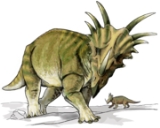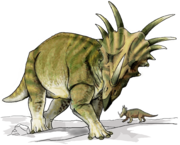
1913 in paleontology
Encyclopedia
Dinosaurs
- A US Geological Survey crew headed by Eugene Stebinger and a US National Museum crew headed by Charles Gilmore worked together to excavate the first dinosaur discovery of the Two Medicine FormationTwo Medicine FormationThe Two Medicine Formation is a geologic formation, or rock body, that was deposited between 83.5 ± 0.7 Ma to 70.6 ± 0.6 Ma , during Campanian time, and is located in northwestern Montana...
.
Newly named dinosaurs
Data courtesy of George OlshevskyGeorge Olshevsky
George Olshevsky is a freelance editor, writer, publisher, amateur paleontologist, and mathematician living in San Diego, California.Olshevsky maintains the comprehensive online Dinosaur Genera List...
's dinosaur genera list and Dr. Jeremy Montague's dinosaur genus database.
| Name | Status | Authors | Notes | Images | |
|---|---|---|---|---|---|
| "Aggiosaurus" | Misidentification. |
|
A misidentified metriorhynchid. |
  |
|
"Elopteryx Elopteryx Elopteryx is a genus of troodontid maniraptoran theropod dinosaur based on fragmentary fossils found in late Cretaceous Period rocks of Romania. These fossils date from the early-mid Maastrichtian faunal stage, c.71-68 million years ago... " |
Nomen dubium Nomen dubium In zoological nomenclature, a nomen dubium is a scientific name that is of unknown or doubtful application... . |
|
Probable a misidentified bird Bird Birds are feathered, winged, bipedal, endothermic , egg-laying, vertebrate animals. Around 10,000 living species and 188 families makes them the most speciose class of tetrapod vertebrates. They inhabit ecosystems across the globe, from the Arctic to the Antarctic. Extant birds range in size from... , but may be a troodontid dinosaur. |
||
| Hypacrosaurus Hypacrosaurus Hypacrosaurus was a genus of duckbill dinosaur similar in appearance to Corythosaurus. Like Corythosaurus, it had a tall, hollow rounded crest, although not as large and straight... |
Valid taxon |
|
|||
| Procompsognathus Procompsognathus Procompsognathus is a genus of small theropod dinosaur that lived during the late Triassic period , about 210 million years ago. Procompsognathus was named by Eberhard Fraas in 1913. He named the type species, P... |
Valid taxon |
Eberhard Fraas Eberhard Fraas was a German geologist and paleontologist. He worked as a curator at the Stuttgarter Naturaliensammlung and discovered the dinosaurs of the Tendaguru formation in then German East Africa .... |
|||
|
"Pterospondylus Pterospondylus Pterospondylus is a dubious genus of theropod dinosaur from the Late Triassic. It was a coelophysoid theropod which lived in what is now Germany . The type species, Pterospondylus trielbae, was described by Jaekel in 1913-14 for a single back vertebra... " |
Disputed. |
|
Possible junior synonym of Procompsognathus Procompsognathus Procompsognathus is a genus of small theropod dinosaur that lived during the late Triassic period , about 210 million years ago. Procompsognathus was named by Eberhard Fraas in 1913. He named the type species, P... . |
||
| Styracosaurus Styracosaurus Styracosaurus was a genus of herbivorous ceratopsian dinosaur from the Cretaceous Period , about 76.5 to 75.0 million years ago... |
Valid taxon |
|
|||
| Thescelosaurus Thescelosaurus Thescelosaurus was a genus of small ornithopod dinosaur that appeared at the very end of the Late Cretaceous period in North America. It was a member of the last dinosaurian fauna before the Cretaceous-Tertiary extinction event around 65.5 million years ago... |
Valid taxon |
Charles W. Gilmore Charles Whitney Gilmore was an American paleontologist, who named dinosaurs in North America and Mongolia, including the Cretaceous sauropod Alamosaurus, Alectrosaurus, Archaeornithomimus, Bactrosaurus, Brachyceratops, Chirostenotes, Mongolosaurus, Parrosaurus, Pinacosaurus, Styracosaurus and... |
|||
New taxa
| s="wikitable sortable" align="center" width="100%"> | ||||
| Name | Status | Authors | Notes | |
|---|---|---|---|---|
Leurospondylus Leurospondylus Leurospondylus is a genus of plesiosaur whose family is not known for certain, but is thought to be Plesiosauridae.-Etymology:The name Leurospondylus comes from a fusion of two Greek words, leuros meaning "even", "flat" or "smooth", and spondylos meaning "vertebra." The name of the type species L... |
Valid |
Brown |
||
Ogmodirus Ogmodirus Ogmodirus is an extinct genus of plesiosaur with an extremely long neck that lived in the Cretaceous. It may be member of the Elasmosauridae, a group of marine animals related to Elasmosaurus, but the condition of the fossils discovered to date means the genus is dubious. The type species,... |
Valid |
Williston Moodie |
||
Non-mammalian
| Name | Status | Authors | Discovery year | Age | Unit | Location | Notes | Images |
|---|---|---|---|---|---|---|---|---|
Diictodon Diictodon Diictodon was a genus of therapsid, roughly 45 cm long. It belonged to the sub-group Dicynodontia. These mammal-like synapsids lived during the Late Permian period, approximately 255 million years ago. Fossils have been found in Africa and Asia... |
Valid |
|||||||
Eocyclops |
Valid |
|||||||
Ictidorhinus Ictidorhinus Ictidorhinus is an extinct genus of ictidorhinid biarmosuchian. Fossils have been found from the Dicynodon Assemblage Zone of the Beaufort Group in the Karoo Basin, South Africa and are of Late Permian age. It had a short snout and proportionally large orbits. Some have considered these... |
Valid |
|||||||
Scylacops Scylacops Scylacops is an extinct genus of Gorgonopsia. It was first named by Broom in 1913, and contains two species, S. bigendens, and S. capensis. Its fossils have been found in South Africa. It is believed to be closely related to the Gorgonopsian Sauroctonus progressus. Scylacops was a moderately-sized... |
Valid |
|||||||

